Investigating Unconventional Financing Impacts on SMEs in Nigeria
VerifiedAdded on 2023/05/28
|21
|5457
|400
Report
AI Summary
This research investigates the impact of unconventional financing methods on the performance of Small and Medium Enterprises (SMEs) in Nigeria, addressing the challenges SMEs face in securing capital investment. The study explores the operating environment for SMEs in Nigeria, identifying weaknesses and gaps in the sector. It employs questionnaires and interviews in Lagos to gather data on various unconventional financing alternatives, such as peer-to-peer lending, crowdfunding, blockchain technology, trade credit, trust funds, rotational savings, strategic alliances, and inheritance. The research aims to determine the extent to which these methods affect SME performance, measured by employee acquisition, profitability, and customer acquisition. Reliability is tested using Cronbach's Alpha, and validity is ensured through pilot testing, with the study conducted over four months. The ultimate goal is to provide insights into the role of unconventional financing in the operations and growth of Nigerian SMEs, given the limited access to conventional financing.

Running head: UNCONVENTIONAL FINANCING IN NIGERIA
An Investigation of the Impacts of Unconventional Financing on the Performance of SMEs in
Nigeria
Author’s Name
College
An Investigation of the Impacts of Unconventional Financing on the Performance of SMEs in
Nigeria
Author’s Name
College
Paraphrase This Document
Need a fresh take? Get an instant paraphrase of this document with our AI Paraphraser
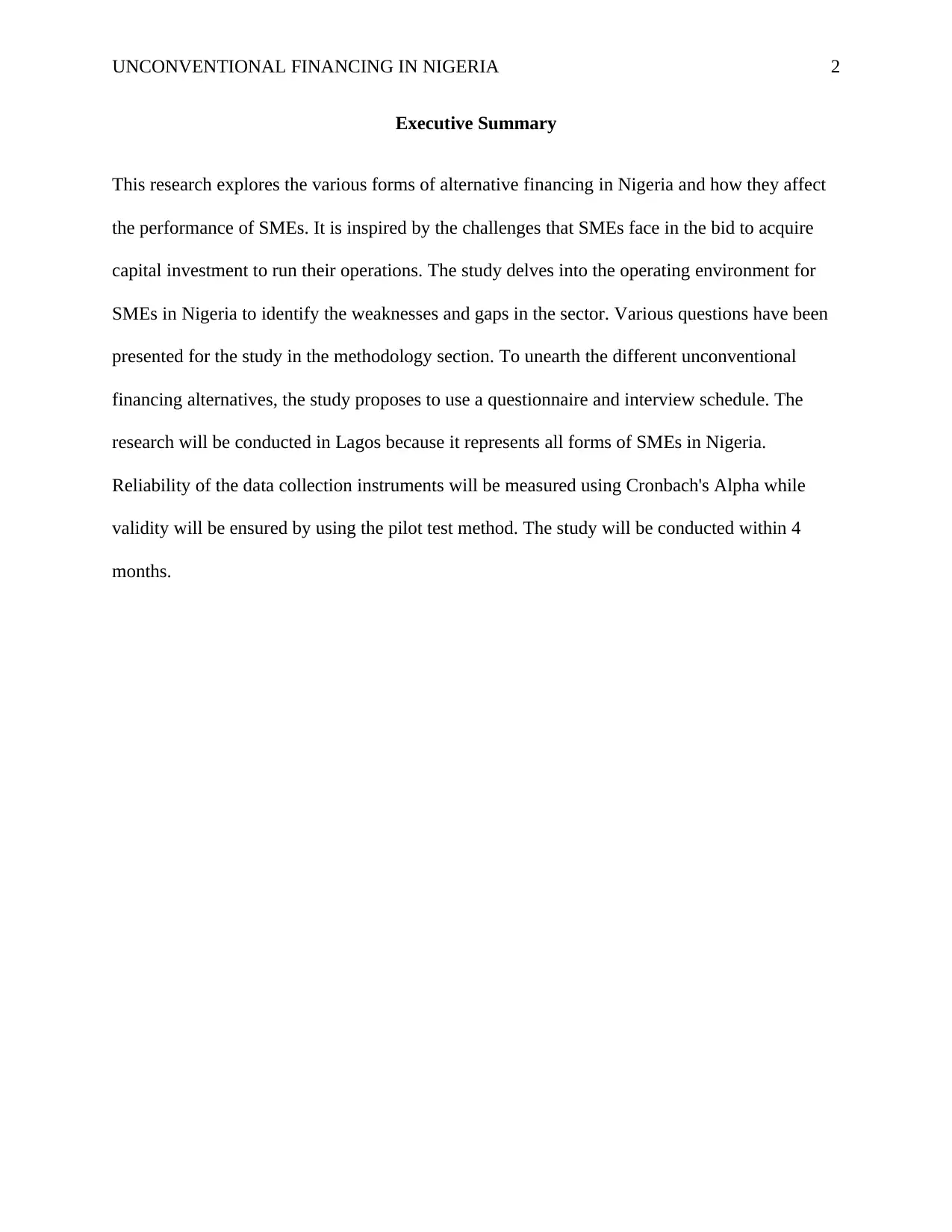
UNCONVENTIONAL FINANCING IN NIGERIA 2
Executive Summary
This research explores the various forms of alternative financing in Nigeria and how they affect
the performance of SMEs. It is inspired by the challenges that SMEs face in the bid to acquire
capital investment to run their operations. The study delves into the operating environment for
SMEs in Nigeria to identify the weaknesses and gaps in the sector. Various questions have been
presented for the study in the methodology section. To unearth the different unconventional
financing alternatives, the study proposes to use a questionnaire and interview schedule. The
research will be conducted in Lagos because it represents all forms of SMEs in Nigeria.
Reliability of the data collection instruments will be measured using Cronbach's Alpha while
validity will be ensured by using the pilot test method. The study will be conducted within 4
months.
Executive Summary
This research explores the various forms of alternative financing in Nigeria and how they affect
the performance of SMEs. It is inspired by the challenges that SMEs face in the bid to acquire
capital investment to run their operations. The study delves into the operating environment for
SMEs in Nigeria to identify the weaknesses and gaps in the sector. Various questions have been
presented for the study in the methodology section. To unearth the different unconventional
financing alternatives, the study proposes to use a questionnaire and interview schedule. The
research will be conducted in Lagos because it represents all forms of SMEs in Nigeria.
Reliability of the data collection instruments will be measured using Cronbach's Alpha while
validity will be ensured by using the pilot test method. The study will be conducted within 4
months.
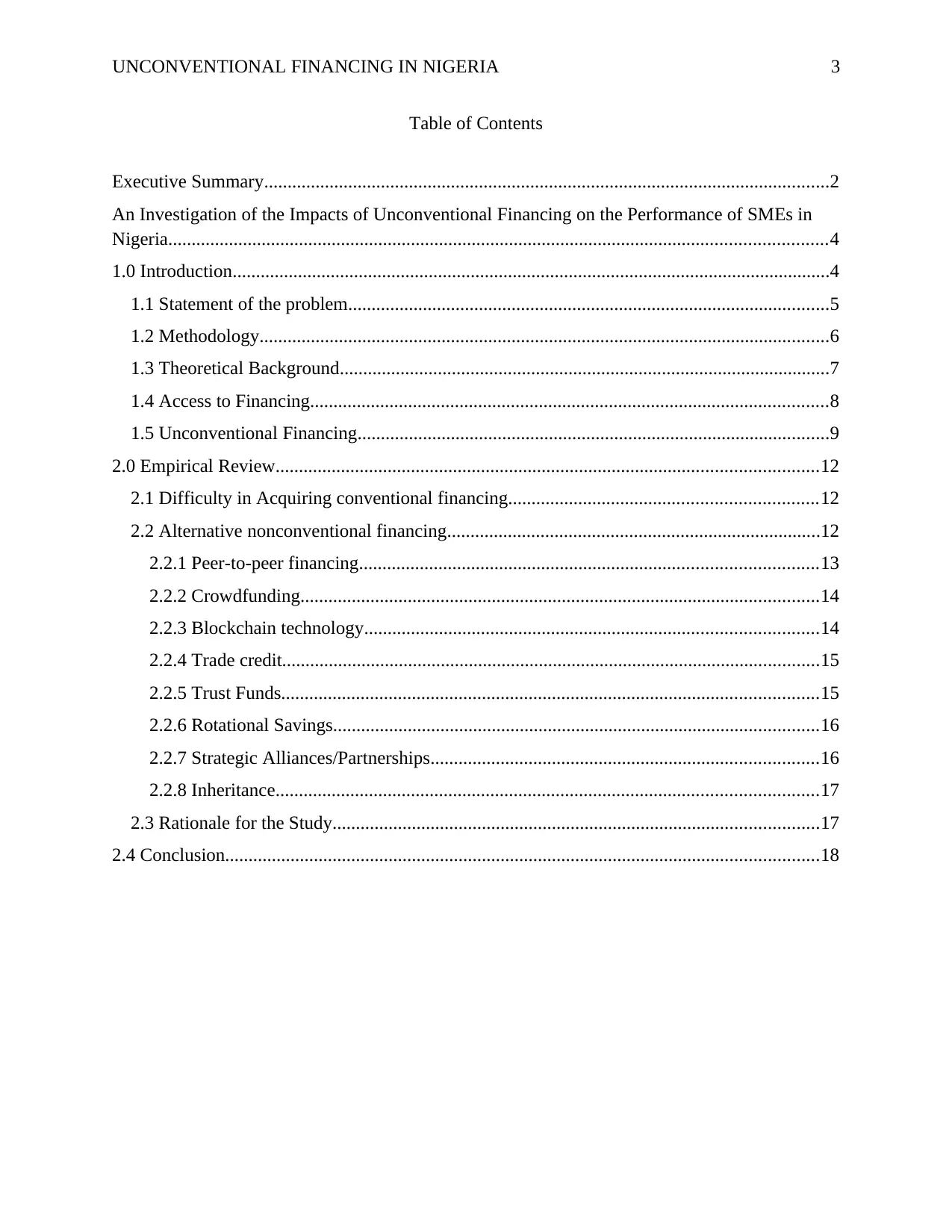
UNCONVENTIONAL FINANCING IN NIGERIA 3
Table of Contents
Executive Summary.........................................................................................................................2
An Investigation of the Impacts of Unconventional Financing on the Performance of SMEs in
Nigeria.............................................................................................................................................4
1.0 Introduction................................................................................................................................4
1.1 Statement of the problem.......................................................................................................5
1.2 Methodology..........................................................................................................................6
1.3 Theoretical Background.........................................................................................................7
1.4 Access to Financing...............................................................................................................8
1.5 Unconventional Financing.....................................................................................................9
2.0 Empirical Review....................................................................................................................12
2.1 Difficulty in Acquiring conventional financing..................................................................12
2.2 Alternative nonconventional financing................................................................................12
2.2.1 Peer-to-peer financing..................................................................................................13
2.2.2 Crowdfunding...............................................................................................................14
2.2.3 Blockchain technology.................................................................................................14
2.2.4 Trade credit...................................................................................................................15
2.2.5 Trust Funds...................................................................................................................15
2.2.6 Rotational Savings........................................................................................................16
2.2.7 Strategic Alliances/Partnerships...................................................................................16
2.2.8 Inheritance....................................................................................................................17
2.3 Rationale for the Study........................................................................................................17
2.4 Conclusion...............................................................................................................................18
Table of Contents
Executive Summary.........................................................................................................................2
An Investigation of the Impacts of Unconventional Financing on the Performance of SMEs in
Nigeria.............................................................................................................................................4
1.0 Introduction................................................................................................................................4
1.1 Statement of the problem.......................................................................................................5
1.2 Methodology..........................................................................................................................6
1.3 Theoretical Background.........................................................................................................7
1.4 Access to Financing...............................................................................................................8
1.5 Unconventional Financing.....................................................................................................9
2.0 Empirical Review....................................................................................................................12
2.1 Difficulty in Acquiring conventional financing..................................................................12
2.2 Alternative nonconventional financing................................................................................12
2.2.1 Peer-to-peer financing..................................................................................................13
2.2.2 Crowdfunding...............................................................................................................14
2.2.3 Blockchain technology.................................................................................................14
2.2.4 Trade credit...................................................................................................................15
2.2.5 Trust Funds...................................................................................................................15
2.2.6 Rotational Savings........................................................................................................16
2.2.7 Strategic Alliances/Partnerships...................................................................................16
2.2.8 Inheritance....................................................................................................................17
2.3 Rationale for the Study........................................................................................................17
2.4 Conclusion...............................................................................................................................18
⊘ This is a preview!⊘
Do you want full access?
Subscribe today to unlock all pages.

Trusted by 1+ million students worldwide
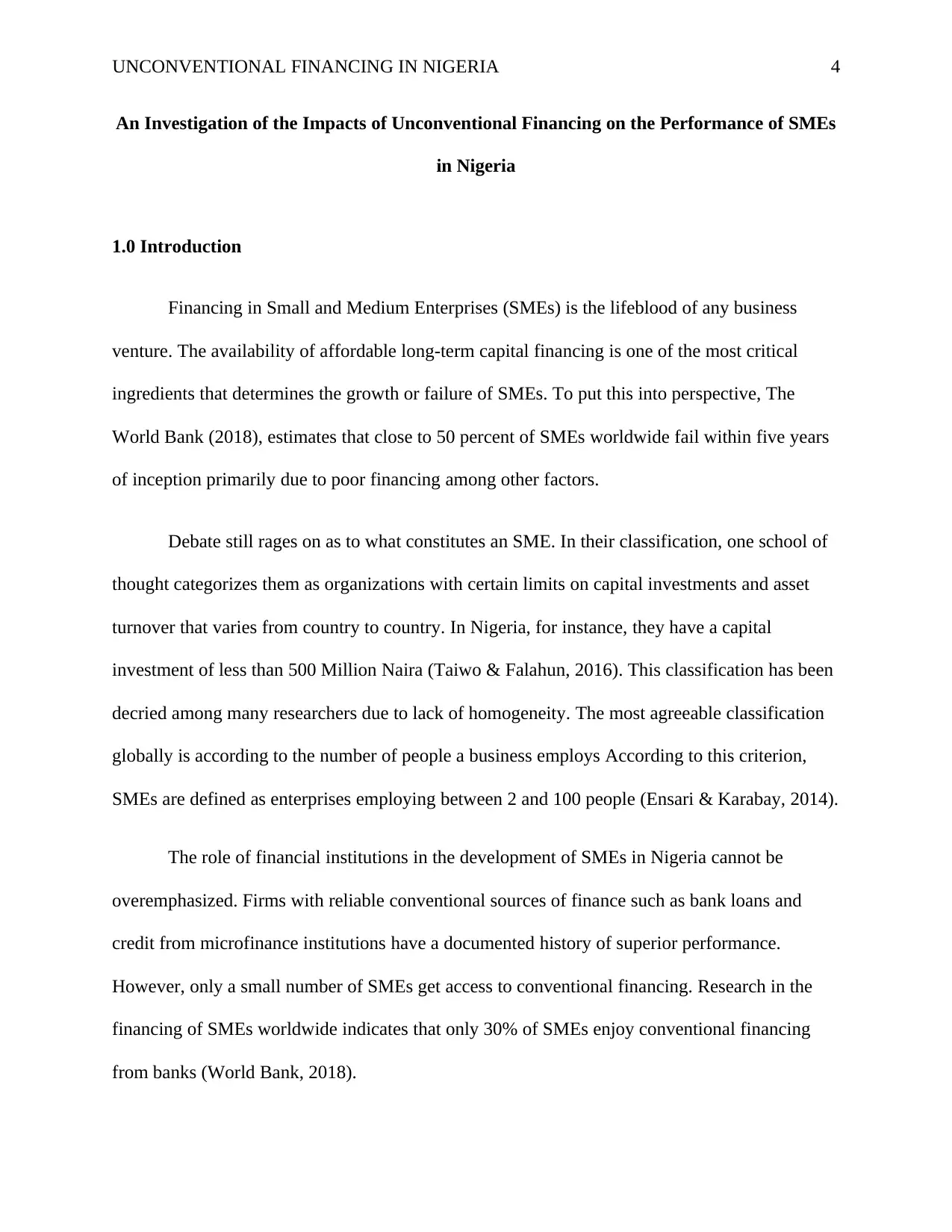
UNCONVENTIONAL FINANCING IN NIGERIA 4
An Investigation of the Impacts of Unconventional Financing on the Performance of SMEs
in Nigeria
1.0 Introduction
Financing in Small and Medium Enterprises (SMEs) is the lifeblood of any business
venture. The availability of affordable long-term capital financing is one of the most critical
ingredients that determines the growth or failure of SMEs. To put this into perspective, The
World Bank (2018), estimates that close to 50 percent of SMEs worldwide fail within five years
of inception primarily due to poor financing among other factors.
Debate still rages on as to what constitutes an SME. In their classification, one school of
thought categorizes them as organizations with certain limits on capital investments and asset
turnover that varies from country to country. In Nigeria, for instance, they have a capital
investment of less than 500 Million Naira (Taiwo & Falahun, 2016). This classification has been
decried among many researchers due to lack of homogeneity. The most agreeable classification
globally is according to the number of people a business employs According to this criterion,
SMEs are defined as enterprises employing between 2 and 100 people (Ensari & Karabay, 2014).
The role of financial institutions in the development of SMEs in Nigeria cannot be
overemphasized. Firms with reliable conventional sources of finance such as bank loans and
credit from microfinance institutions have a documented history of superior performance.
However, only a small number of SMEs get access to conventional financing. Research in the
financing of SMEs worldwide indicates that only 30% of SMEs enjoy conventional financing
from banks (World Bank, 2018).
An Investigation of the Impacts of Unconventional Financing on the Performance of SMEs
in Nigeria
1.0 Introduction
Financing in Small and Medium Enterprises (SMEs) is the lifeblood of any business
venture. The availability of affordable long-term capital financing is one of the most critical
ingredients that determines the growth or failure of SMEs. To put this into perspective, The
World Bank (2018), estimates that close to 50 percent of SMEs worldwide fail within five years
of inception primarily due to poor financing among other factors.
Debate still rages on as to what constitutes an SME. In their classification, one school of
thought categorizes them as organizations with certain limits on capital investments and asset
turnover that varies from country to country. In Nigeria, for instance, they have a capital
investment of less than 500 Million Naira (Taiwo & Falahun, 2016). This classification has been
decried among many researchers due to lack of homogeneity. The most agreeable classification
globally is according to the number of people a business employs According to this criterion,
SMEs are defined as enterprises employing between 2 and 100 people (Ensari & Karabay, 2014).
The role of financial institutions in the development of SMEs in Nigeria cannot be
overemphasized. Firms with reliable conventional sources of finance such as bank loans and
credit from microfinance institutions have a documented history of superior performance.
However, only a small number of SMEs get access to conventional financing. Research in the
financing of SMEs worldwide indicates that only 30% of SMEs enjoy conventional financing
from banks (World Bank, 2018).
Paraphrase This Document
Need a fresh take? Get an instant paraphrase of this document with our AI Paraphraser
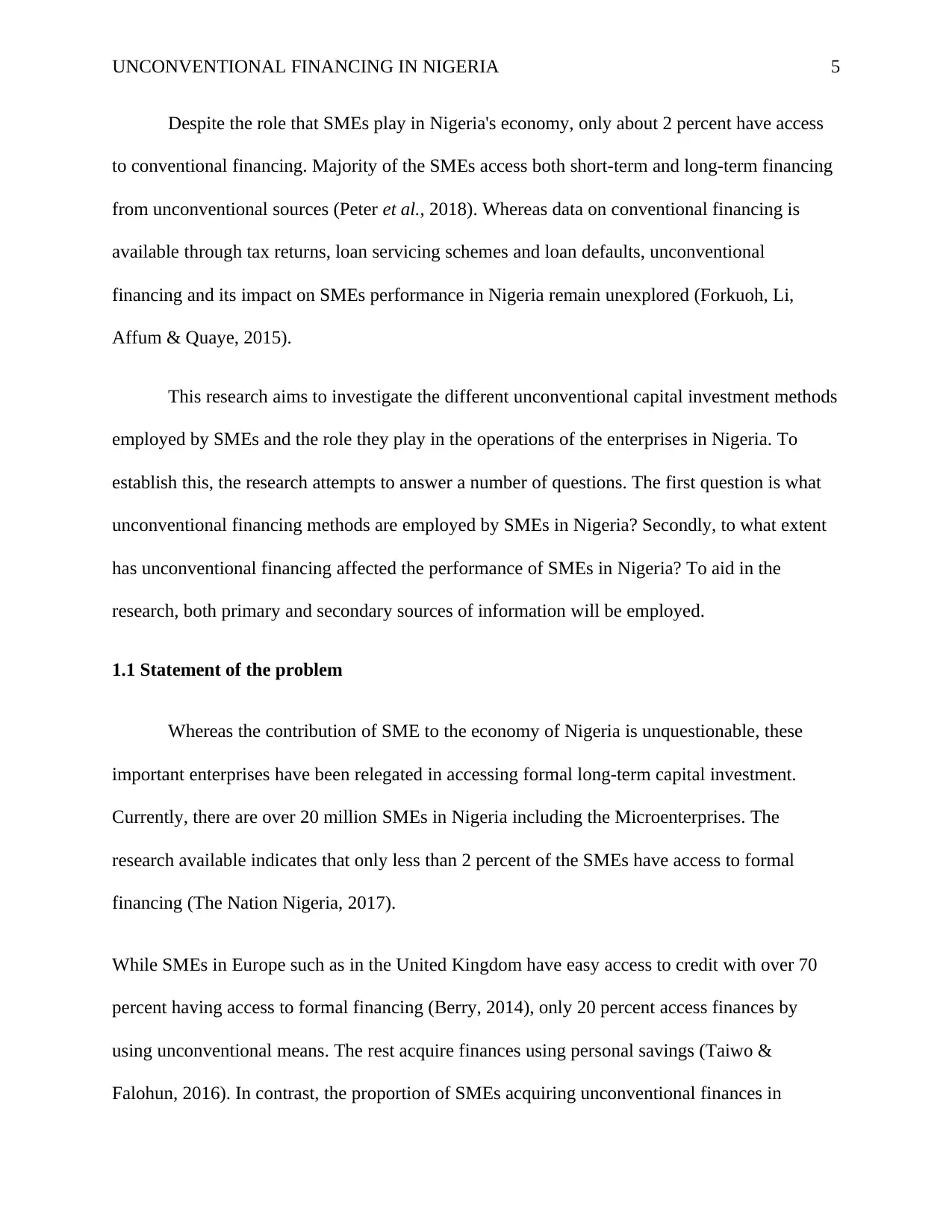
UNCONVENTIONAL FINANCING IN NIGERIA 5
Despite the role that SMEs play in Nigeria's economy, only about 2 percent have access
to conventional financing. Majority of the SMEs access both short-term and long-term financing
from unconventional sources (Peter et al., 2018). Whereas data on conventional financing is
available through tax returns, loan servicing schemes and loan defaults, unconventional
financing and its impact on SMEs performance in Nigeria remain unexplored (Forkuoh, Li,
Affum & Quaye, 2015).
This research aims to investigate the different unconventional capital investment methods
employed by SMEs and the role they play in the operations of the enterprises in Nigeria. To
establish this, the research attempts to answer a number of questions. The first question is what
unconventional financing methods are employed by SMEs in Nigeria? Secondly, to what extent
has unconventional financing affected the performance of SMEs in Nigeria? To aid in the
research, both primary and secondary sources of information will be employed.
1.1 Statement of the problem
Whereas the contribution of SME to the economy of Nigeria is unquestionable, these
important enterprises have been relegated in accessing formal long-term capital investment.
Currently, there are over 20 million SMEs in Nigeria including the Microenterprises. The
research available indicates that only less than 2 percent of the SMEs have access to formal
financing (The Nation Nigeria, 2017).
While SMEs in Europe such as in the United Kingdom have easy access to credit with over 70
percent having access to formal financing (Berry, 2014), only 20 percent access finances by
using unconventional means. The rest acquire finances using personal savings (Taiwo &
Falohun, 2016). In contrast, the proportion of SMEs acquiring unconventional finances in
Despite the role that SMEs play in Nigeria's economy, only about 2 percent have access
to conventional financing. Majority of the SMEs access both short-term and long-term financing
from unconventional sources (Peter et al., 2018). Whereas data on conventional financing is
available through tax returns, loan servicing schemes and loan defaults, unconventional
financing and its impact on SMEs performance in Nigeria remain unexplored (Forkuoh, Li,
Affum & Quaye, 2015).
This research aims to investigate the different unconventional capital investment methods
employed by SMEs and the role they play in the operations of the enterprises in Nigeria. To
establish this, the research attempts to answer a number of questions. The first question is what
unconventional financing methods are employed by SMEs in Nigeria? Secondly, to what extent
has unconventional financing affected the performance of SMEs in Nigeria? To aid in the
research, both primary and secondary sources of information will be employed.
1.1 Statement of the problem
Whereas the contribution of SME to the economy of Nigeria is unquestionable, these
important enterprises have been relegated in accessing formal long-term capital investment.
Currently, there are over 20 million SMEs in Nigeria including the Microenterprises. The
research available indicates that only less than 2 percent of the SMEs have access to formal
financing (The Nation Nigeria, 2017).
While SMEs in Europe such as in the United Kingdom have easy access to credit with over 70
percent having access to formal financing (Berry, 2014), only 20 percent access finances by
using unconventional means. The rest acquire finances using personal savings (Taiwo &
Falohun, 2016). In contrast, the proportion of SMEs acquiring unconventional finances in
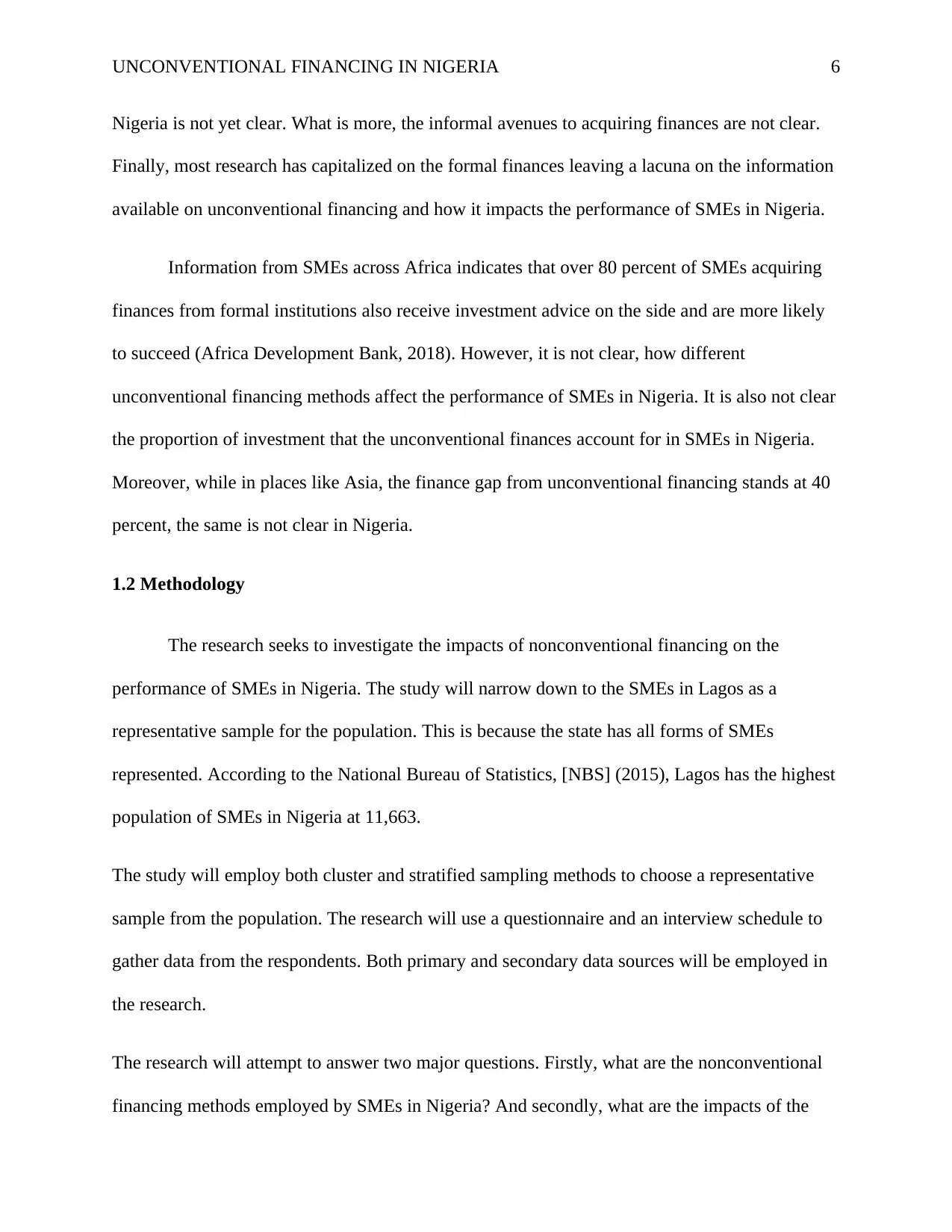
UNCONVENTIONAL FINANCING IN NIGERIA 6
Nigeria is not yet clear. What is more, the informal avenues to acquiring finances are not clear.
Finally, most research has capitalized on the formal finances leaving a lacuna on the information
available on unconventional financing and how it impacts the performance of SMEs in Nigeria.
Information from SMEs across Africa indicates that over 80 percent of SMEs acquiring
finances from formal institutions also receive investment advice on the side and are more likely
to succeed (Africa Development Bank, 2018). However, it is not clear, how different
unconventional financing methods affect the performance of SMEs in Nigeria. It is also not clear
the proportion of investment that the unconventional finances account for in SMEs in Nigeria.
Moreover, while in places like Asia, the finance gap from unconventional financing stands at 40
percent, the same is not clear in Nigeria.
1.2 Methodology
The research seeks to investigate the impacts of nonconventional financing on the
performance of SMEs in Nigeria. The study will narrow down to the SMEs in Lagos as a
representative sample for the population. This is because the state has all forms of SMEs
represented. According to the National Bureau of Statistics, [NBS] (2015), Lagos has the highest
population of SMEs in Nigeria at 11,663.
The study will employ both cluster and stratified sampling methods to choose a representative
sample from the population. The research will use a questionnaire and an interview schedule to
gather data from the respondents. Both primary and secondary data sources will be employed in
the research.
The research will attempt to answer two major questions. Firstly, what are the nonconventional
financing methods employed by SMEs in Nigeria? And secondly, what are the impacts of the
Nigeria is not yet clear. What is more, the informal avenues to acquiring finances are not clear.
Finally, most research has capitalized on the formal finances leaving a lacuna on the information
available on unconventional financing and how it impacts the performance of SMEs in Nigeria.
Information from SMEs across Africa indicates that over 80 percent of SMEs acquiring
finances from formal institutions also receive investment advice on the side and are more likely
to succeed (Africa Development Bank, 2018). However, it is not clear, how different
unconventional financing methods affect the performance of SMEs in Nigeria. It is also not clear
the proportion of investment that the unconventional finances account for in SMEs in Nigeria.
Moreover, while in places like Asia, the finance gap from unconventional financing stands at 40
percent, the same is not clear in Nigeria.
1.2 Methodology
The research seeks to investigate the impacts of nonconventional financing on the
performance of SMEs in Nigeria. The study will narrow down to the SMEs in Lagos as a
representative sample for the population. This is because the state has all forms of SMEs
represented. According to the National Bureau of Statistics, [NBS] (2015), Lagos has the highest
population of SMEs in Nigeria at 11,663.
The study will employ both cluster and stratified sampling methods to choose a representative
sample from the population. The research will use a questionnaire and an interview schedule to
gather data from the respondents. Both primary and secondary data sources will be employed in
the research.
The research will attempt to answer two major questions. Firstly, what are the nonconventional
financing methods employed by SMEs in Nigeria? And secondly, what are the impacts of the
⊘ This is a preview!⊘
Do you want full access?
Subscribe today to unlock all pages.

Trusted by 1+ million students worldwide
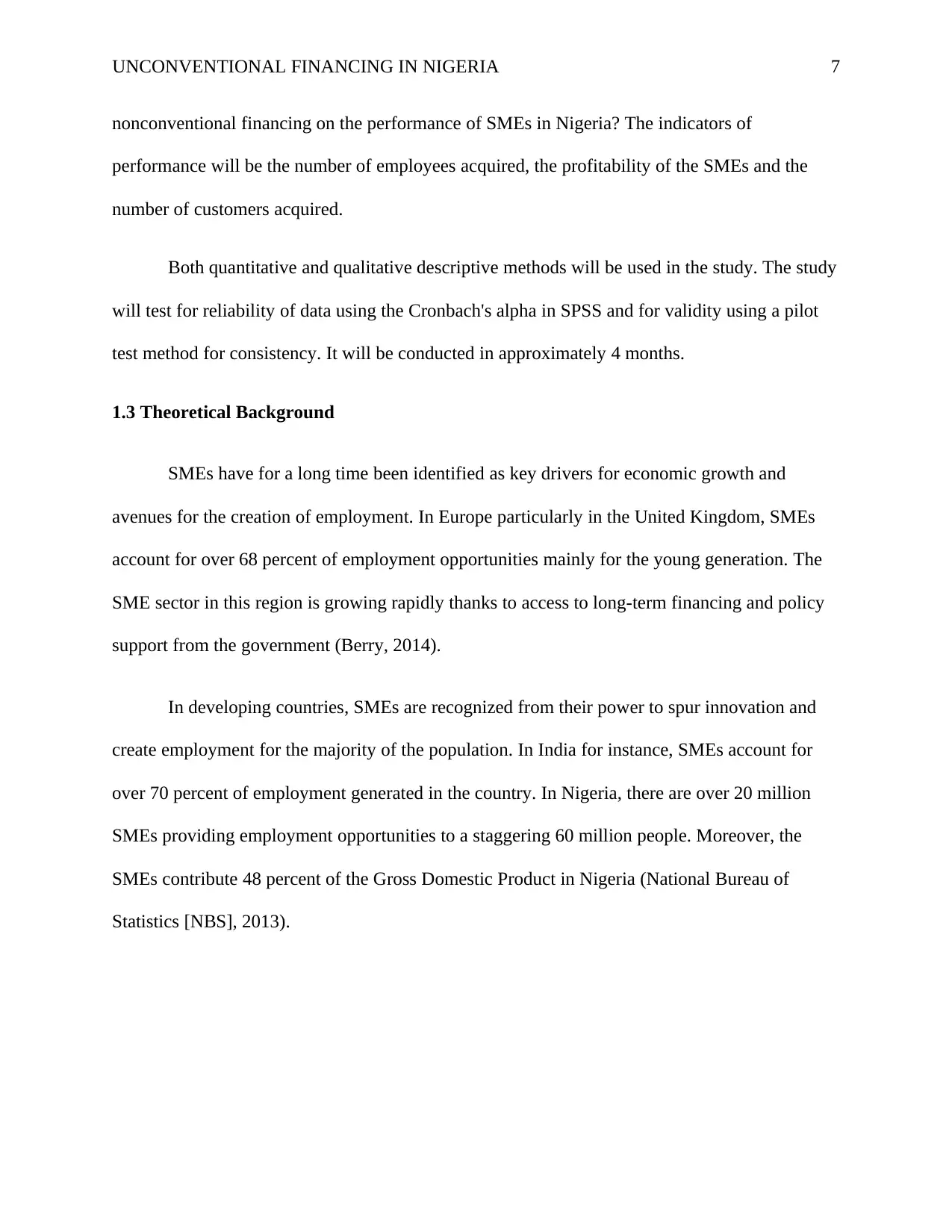
UNCONVENTIONAL FINANCING IN NIGERIA 7
nonconventional financing on the performance of SMEs in Nigeria? The indicators of
performance will be the number of employees acquired, the profitability of the SMEs and the
number of customers acquired.
Both quantitative and qualitative descriptive methods will be used in the study. The study
will test for reliability of data using the Cronbach's alpha in SPSS and for validity using a pilot
test method for consistency. It will be conducted in approximately 4 months.
1.3 Theoretical Background
SMEs have for a long time been identified as key drivers for economic growth and
avenues for the creation of employment. In Europe particularly in the United Kingdom, SMEs
account for over 68 percent of employment opportunities mainly for the young generation. The
SME sector in this region is growing rapidly thanks to access to long-term financing and policy
support from the government (Berry, 2014).
In developing countries, SMEs are recognized from their power to spur innovation and
create employment for the majority of the population. In India for instance, SMEs account for
over 70 percent of employment generated in the country. In Nigeria, there are over 20 million
SMEs providing employment opportunities to a staggering 60 million people. Moreover, the
SMEs contribute 48 percent of the Gross Domestic Product in Nigeria (National Bureau of
Statistics [NBS], 2013).
nonconventional financing on the performance of SMEs in Nigeria? The indicators of
performance will be the number of employees acquired, the profitability of the SMEs and the
number of customers acquired.
Both quantitative and qualitative descriptive methods will be used in the study. The study
will test for reliability of data using the Cronbach's alpha in SPSS and for validity using a pilot
test method for consistency. It will be conducted in approximately 4 months.
1.3 Theoretical Background
SMEs have for a long time been identified as key drivers for economic growth and
avenues for the creation of employment. In Europe particularly in the United Kingdom, SMEs
account for over 68 percent of employment opportunities mainly for the young generation. The
SME sector in this region is growing rapidly thanks to access to long-term financing and policy
support from the government (Berry, 2014).
In developing countries, SMEs are recognized from their power to spur innovation and
create employment for the majority of the population. In India for instance, SMEs account for
over 70 percent of employment generated in the country. In Nigeria, there are over 20 million
SMEs providing employment opportunities to a staggering 60 million people. Moreover, the
SMEs contribute 48 percent of the Gross Domestic Product in Nigeria (National Bureau of
Statistics [NBS], 2013).
Paraphrase This Document
Need a fresh take? Get an instant paraphrase of this document with our AI Paraphraser
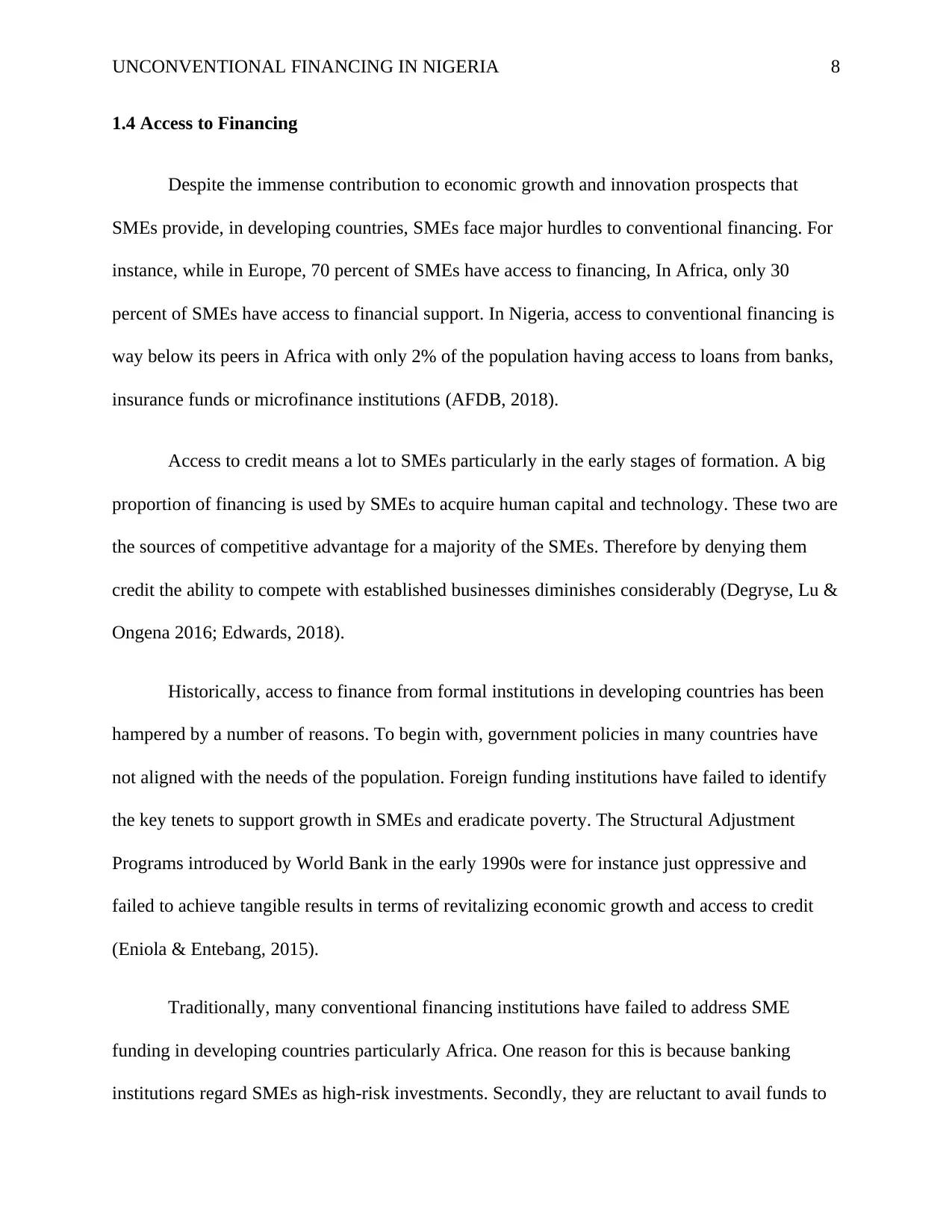
UNCONVENTIONAL FINANCING IN NIGERIA 8
1.4 Access to Financing
Despite the immense contribution to economic growth and innovation prospects that
SMEs provide, in developing countries, SMEs face major hurdles to conventional financing. For
instance, while in Europe, 70 percent of SMEs have access to financing, In Africa, only 30
percent of SMEs have access to financial support. In Nigeria, access to conventional financing is
way below its peers in Africa with only 2% of the population having access to loans from banks,
insurance funds or microfinance institutions (AFDB, 2018).
Access to credit means a lot to SMEs particularly in the early stages of formation. A big
proportion of financing is used by SMEs to acquire human capital and technology. These two are
the sources of competitive advantage for a majority of the SMEs. Therefore by denying them
credit the ability to compete with established businesses diminishes considerably (Degryse, Lu &
Ongena 2016; Edwards, 2018).
Historically, access to finance from formal institutions in developing countries has been
hampered by a number of reasons. To begin with, government policies in many countries have
not aligned with the needs of the population. Foreign funding institutions have failed to identify
the key tenets to support growth in SMEs and eradicate poverty. The Structural Adjustment
Programs introduced by World Bank in the early 1990s were for instance just oppressive and
failed to achieve tangible results in terms of revitalizing economic growth and access to credit
(Eniola & Entebang, 2015).
Traditionally, many conventional financing institutions have failed to address SME
funding in developing countries particularly Africa. One reason for this is because banking
institutions regard SMEs as high-risk investments. Secondly, they are reluctant to avail funds to
1.4 Access to Financing
Despite the immense contribution to economic growth and innovation prospects that
SMEs provide, in developing countries, SMEs face major hurdles to conventional financing. For
instance, while in Europe, 70 percent of SMEs have access to financing, In Africa, only 30
percent of SMEs have access to financial support. In Nigeria, access to conventional financing is
way below its peers in Africa with only 2% of the population having access to loans from banks,
insurance funds or microfinance institutions (AFDB, 2018).
Access to credit means a lot to SMEs particularly in the early stages of formation. A big
proportion of financing is used by SMEs to acquire human capital and technology. These two are
the sources of competitive advantage for a majority of the SMEs. Therefore by denying them
credit the ability to compete with established businesses diminishes considerably (Degryse, Lu &
Ongena 2016; Edwards, 2018).
Historically, access to finance from formal institutions in developing countries has been
hampered by a number of reasons. To begin with, government policies in many countries have
not aligned with the needs of the population. Foreign funding institutions have failed to identify
the key tenets to support growth in SMEs and eradicate poverty. The Structural Adjustment
Programs introduced by World Bank in the early 1990s were for instance just oppressive and
failed to achieve tangible results in terms of revitalizing economic growth and access to credit
(Eniola & Entebang, 2015).
Traditionally, many conventional financing institutions have failed to address SME
funding in developing countries particularly Africa. One reason for this is because banking
institutions regard SMEs as high-risk investments. Secondly, they are reluctant to avail funds to
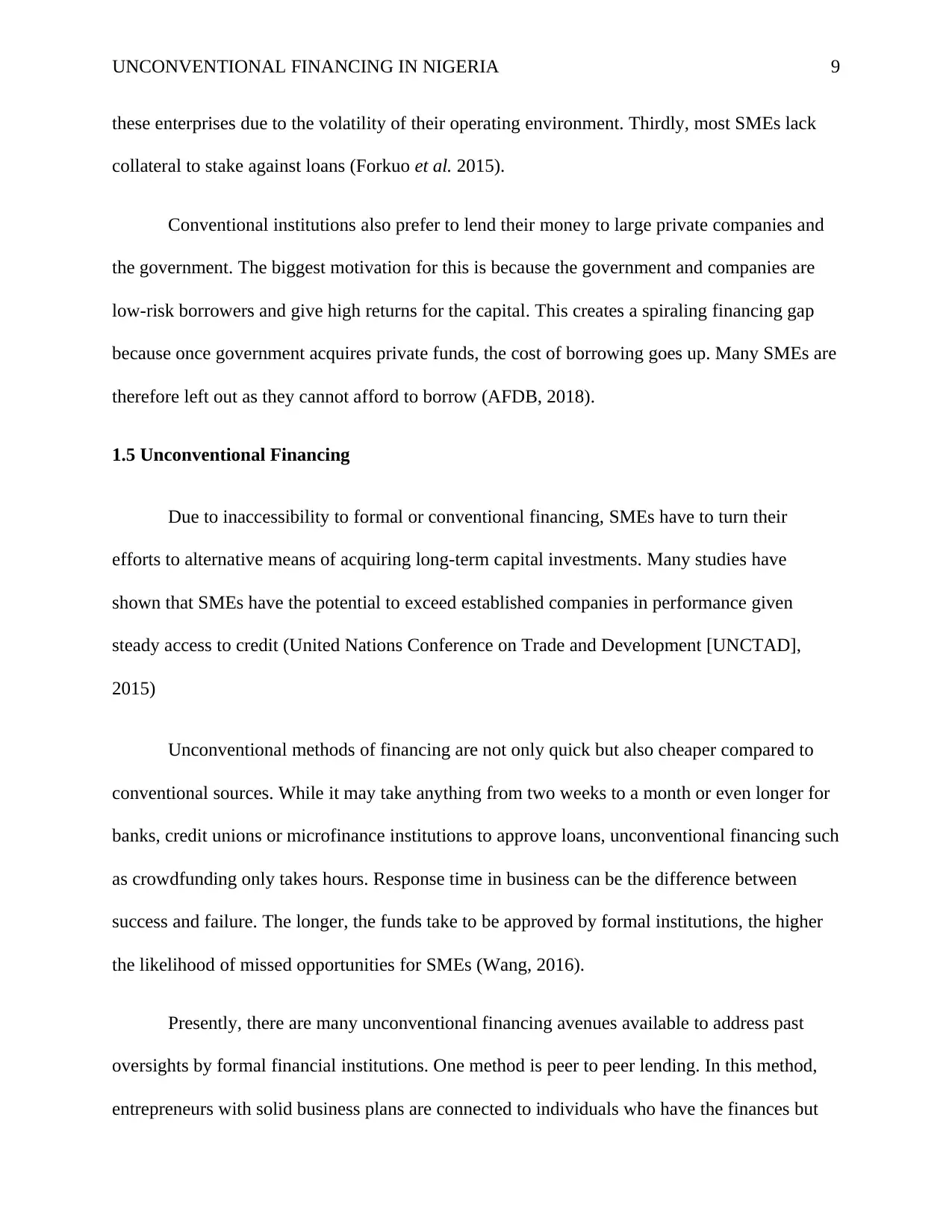
UNCONVENTIONAL FINANCING IN NIGERIA 9
these enterprises due to the volatility of their operating environment. Thirdly, most SMEs lack
collateral to stake against loans (Forkuo et al. 2015).
Conventional institutions also prefer to lend their money to large private companies and
the government. The biggest motivation for this is because the government and companies are
low-risk borrowers and give high returns for the capital. This creates a spiraling financing gap
because once government acquires private funds, the cost of borrowing goes up. Many SMEs are
therefore left out as they cannot afford to borrow (AFDB, 2018).
1.5 Unconventional Financing
Due to inaccessibility to formal or conventional financing, SMEs have to turn their
efforts to alternative means of acquiring long-term capital investments. Many studies have
shown that SMEs have the potential to exceed established companies in performance given
steady access to credit (United Nations Conference on Trade and Development [UNCTAD],
2015)
Unconventional methods of financing are not only quick but also cheaper compared to
conventional sources. While it may take anything from two weeks to a month or even longer for
banks, credit unions or microfinance institutions to approve loans, unconventional financing such
as crowdfunding only takes hours. Response time in business can be the difference between
success and failure. The longer, the funds take to be approved by formal institutions, the higher
the likelihood of missed opportunities for SMEs (Wang, 2016).
Presently, there are many unconventional financing avenues available to address past
oversights by formal financial institutions. One method is peer to peer lending. In this method,
entrepreneurs with solid business plans are connected to individuals who have the finances but
these enterprises due to the volatility of their operating environment. Thirdly, most SMEs lack
collateral to stake against loans (Forkuo et al. 2015).
Conventional institutions also prefer to lend their money to large private companies and
the government. The biggest motivation for this is because the government and companies are
low-risk borrowers and give high returns for the capital. This creates a spiraling financing gap
because once government acquires private funds, the cost of borrowing goes up. Many SMEs are
therefore left out as they cannot afford to borrow (AFDB, 2018).
1.5 Unconventional Financing
Due to inaccessibility to formal or conventional financing, SMEs have to turn their
efforts to alternative means of acquiring long-term capital investments. Many studies have
shown that SMEs have the potential to exceed established companies in performance given
steady access to credit (United Nations Conference on Trade and Development [UNCTAD],
2015)
Unconventional methods of financing are not only quick but also cheaper compared to
conventional sources. While it may take anything from two weeks to a month or even longer for
banks, credit unions or microfinance institutions to approve loans, unconventional financing such
as crowdfunding only takes hours. Response time in business can be the difference between
success and failure. The longer, the funds take to be approved by formal institutions, the higher
the likelihood of missed opportunities for SMEs (Wang, 2016).
Presently, there are many unconventional financing avenues available to address past
oversights by formal financial institutions. One method is peer to peer lending. In this method,
entrepreneurs with solid business plans are connected to individuals who have the finances but
⊘ This is a preview!⊘
Do you want full access?
Subscribe today to unlock all pages.

Trusted by 1+ million students worldwide
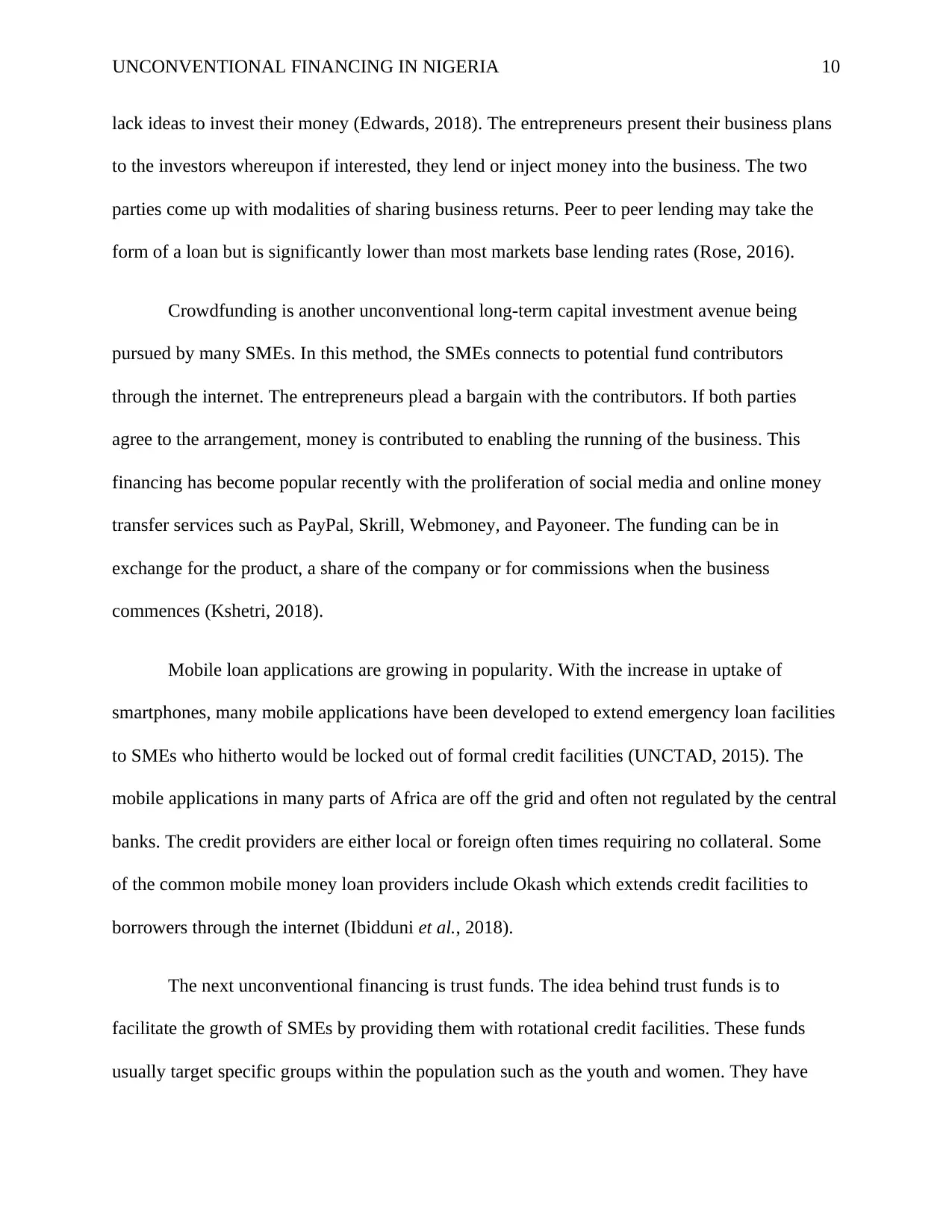
UNCONVENTIONAL FINANCING IN NIGERIA 10
lack ideas to invest their money (Edwards, 2018). The entrepreneurs present their business plans
to the investors whereupon if interested, they lend or inject money into the business. The two
parties come up with modalities of sharing business returns. Peer to peer lending may take the
form of a loan but is significantly lower than most markets base lending rates (Rose, 2016).
Crowdfunding is another unconventional long-term capital investment avenue being
pursued by many SMEs. In this method, the SMEs connects to potential fund contributors
through the internet. The entrepreneurs plead a bargain with the contributors. If both parties
agree to the arrangement, money is contributed to enabling the running of the business. This
financing has become popular recently with the proliferation of social media and online money
transfer services such as PayPal, Skrill, Webmoney, and Payoneer. The funding can be in
exchange for the product, a share of the company or for commissions when the business
commences (Kshetri, 2018).
Mobile loan applications are growing in popularity. With the increase in uptake of
smartphones, many mobile applications have been developed to extend emergency loan facilities
to SMEs who hitherto would be locked out of formal credit facilities (UNCTAD, 2015). The
mobile applications in many parts of Africa are off the grid and often not regulated by the central
banks. The credit providers are either local or foreign often times requiring no collateral. Some
of the common mobile money loan providers include Okash which extends credit facilities to
borrowers through the internet (Ibidduni et al., 2018).
The next unconventional financing is trust funds. The idea behind trust funds is to
facilitate the growth of SMEs by providing them with rotational credit facilities. These funds
usually target specific groups within the population such as the youth and women. They have
lack ideas to invest their money (Edwards, 2018). The entrepreneurs present their business plans
to the investors whereupon if interested, they lend or inject money into the business. The two
parties come up with modalities of sharing business returns. Peer to peer lending may take the
form of a loan but is significantly lower than most markets base lending rates (Rose, 2016).
Crowdfunding is another unconventional long-term capital investment avenue being
pursued by many SMEs. In this method, the SMEs connects to potential fund contributors
through the internet. The entrepreneurs plead a bargain with the contributors. If both parties
agree to the arrangement, money is contributed to enabling the running of the business. This
financing has become popular recently with the proliferation of social media and online money
transfer services such as PayPal, Skrill, Webmoney, and Payoneer. The funding can be in
exchange for the product, a share of the company or for commissions when the business
commences (Kshetri, 2018).
Mobile loan applications are growing in popularity. With the increase in uptake of
smartphones, many mobile applications have been developed to extend emergency loan facilities
to SMEs who hitherto would be locked out of formal credit facilities (UNCTAD, 2015). The
mobile applications in many parts of Africa are off the grid and often not regulated by the central
banks. The credit providers are either local or foreign often times requiring no collateral. Some
of the common mobile money loan providers include Okash which extends credit facilities to
borrowers through the internet (Ibidduni et al., 2018).
The next unconventional financing is trust funds. The idea behind trust funds is to
facilitate the growth of SMEs by providing them with rotational credit facilities. These funds
usually target specific groups within the population such as the youth and women. They have
Paraphrase This Document
Need a fresh take? Get an instant paraphrase of this document with our AI Paraphraser
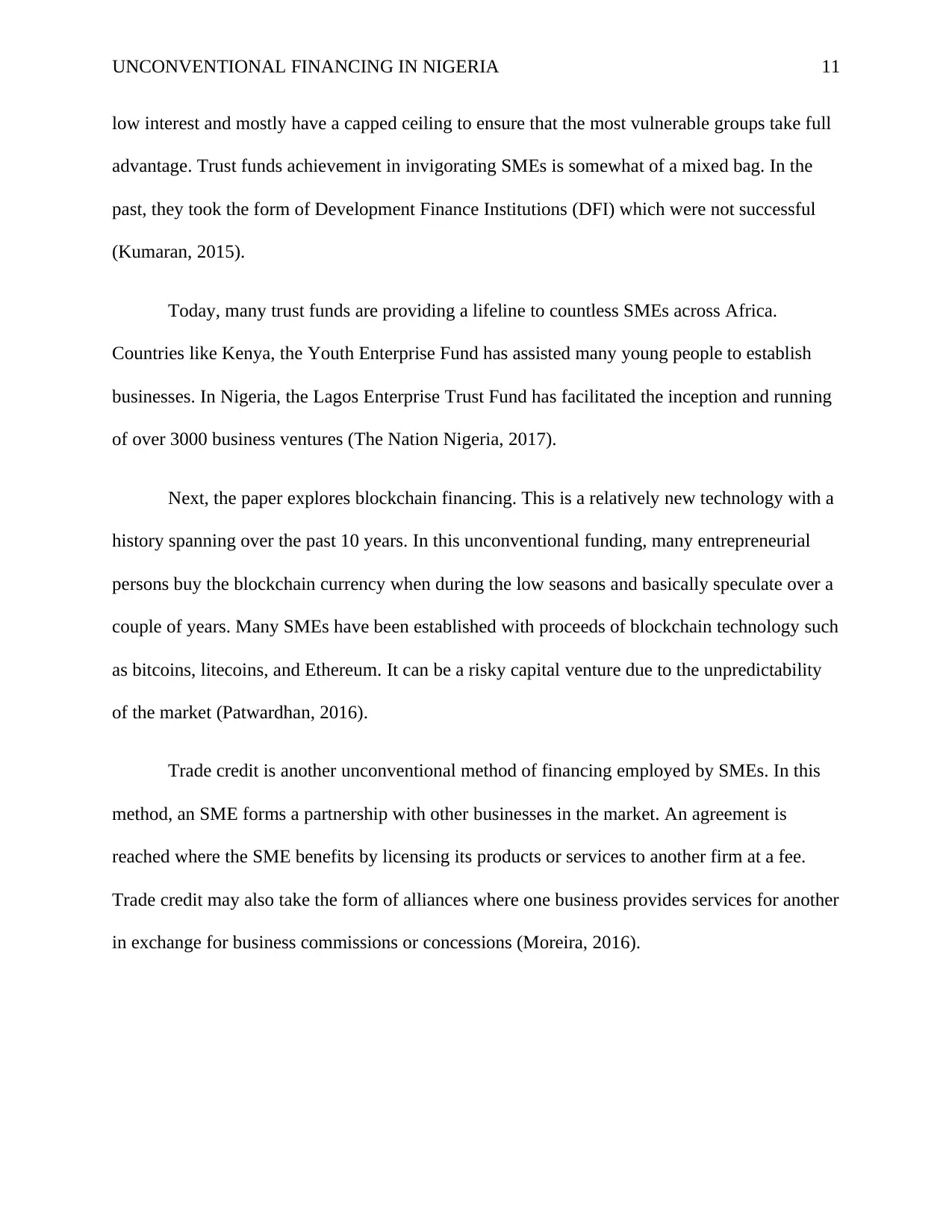
UNCONVENTIONAL FINANCING IN NIGERIA 11
low interest and mostly have a capped ceiling to ensure that the most vulnerable groups take full
advantage. Trust funds achievement in invigorating SMEs is somewhat of a mixed bag. In the
past, they took the form of Development Finance Institutions (DFI) which were not successful
(Kumaran, 2015).
Today, many trust funds are providing a lifeline to countless SMEs across Africa.
Countries like Kenya, the Youth Enterprise Fund has assisted many young people to establish
businesses. In Nigeria, the Lagos Enterprise Trust Fund has facilitated the inception and running
of over 3000 business ventures (The Nation Nigeria, 2017).
Next, the paper explores blockchain financing. This is a relatively new technology with a
history spanning over the past 10 years. In this unconventional funding, many entrepreneurial
persons buy the blockchain currency when during the low seasons and basically speculate over a
couple of years. Many SMEs have been established with proceeds of blockchain technology such
as bitcoins, litecoins, and Ethereum. It can be a risky capital venture due to the unpredictability
of the market (Patwardhan, 2016).
Trade credit is another unconventional method of financing employed by SMEs. In this
method, an SME forms a partnership with other businesses in the market. An agreement is
reached where the SME benefits by licensing its products or services to another firm at a fee.
Trade credit may also take the form of alliances where one business provides services for another
in exchange for business commissions or concessions (Moreira, 2016).
low interest and mostly have a capped ceiling to ensure that the most vulnerable groups take full
advantage. Trust funds achievement in invigorating SMEs is somewhat of a mixed bag. In the
past, they took the form of Development Finance Institutions (DFI) which were not successful
(Kumaran, 2015).
Today, many trust funds are providing a lifeline to countless SMEs across Africa.
Countries like Kenya, the Youth Enterprise Fund has assisted many young people to establish
businesses. In Nigeria, the Lagos Enterprise Trust Fund has facilitated the inception and running
of over 3000 business ventures (The Nation Nigeria, 2017).
Next, the paper explores blockchain financing. This is a relatively new technology with a
history spanning over the past 10 years. In this unconventional funding, many entrepreneurial
persons buy the blockchain currency when during the low seasons and basically speculate over a
couple of years. Many SMEs have been established with proceeds of blockchain technology such
as bitcoins, litecoins, and Ethereum. It can be a risky capital venture due to the unpredictability
of the market (Patwardhan, 2016).
Trade credit is another unconventional method of financing employed by SMEs. In this
method, an SME forms a partnership with other businesses in the market. An agreement is
reached where the SME benefits by licensing its products or services to another firm at a fee.
Trade credit may also take the form of alliances where one business provides services for another
in exchange for business commissions or concessions (Moreira, 2016).
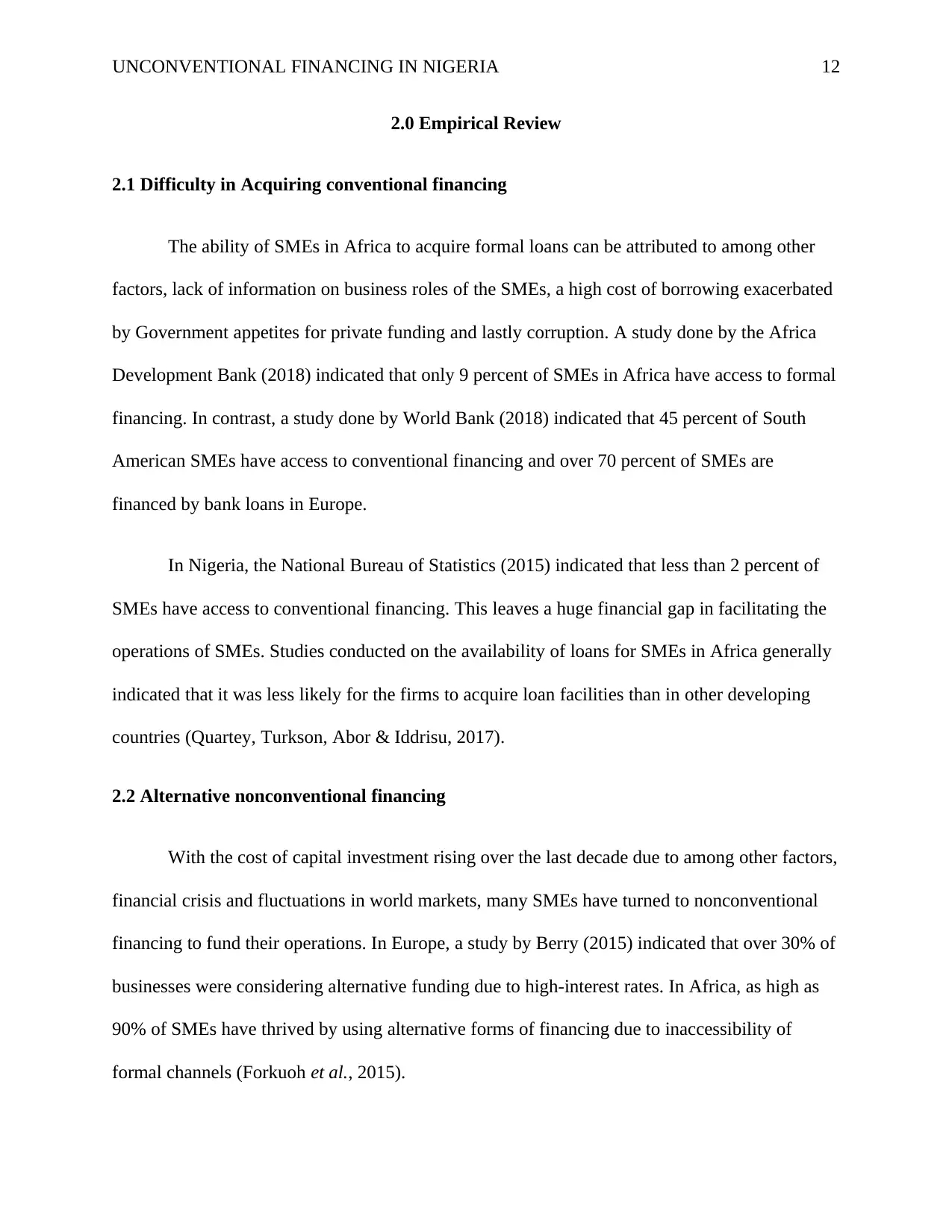
UNCONVENTIONAL FINANCING IN NIGERIA 12
2.0 Empirical Review
2.1 Difficulty in Acquiring conventional financing
The ability of SMEs in Africa to acquire formal loans can be attributed to among other
factors, lack of information on business roles of the SMEs, a high cost of borrowing exacerbated
by Government appetites for private funding and lastly corruption. A study done by the Africa
Development Bank (2018) indicated that only 9 percent of SMEs in Africa have access to formal
financing. In contrast, a study done by World Bank (2018) indicated that 45 percent of South
American SMEs have access to conventional financing and over 70 percent of SMEs are
financed by bank loans in Europe.
In Nigeria, the National Bureau of Statistics (2015) indicated that less than 2 percent of
SMEs have access to conventional financing. This leaves a huge financial gap in facilitating the
operations of SMEs. Studies conducted on the availability of loans for SMEs in Africa generally
indicated that it was less likely for the firms to acquire loan facilities than in other developing
countries (Quartey, Turkson, Abor & Iddrisu, 2017).
2.2 Alternative nonconventional financing
With the cost of capital investment rising over the last decade due to among other factors,
financial crisis and fluctuations in world markets, many SMEs have turned to nonconventional
financing to fund their operations. In Europe, a study by Berry (2015) indicated that over 30% of
businesses were considering alternative funding due to high-interest rates. In Africa, as high as
90% of SMEs have thrived by using alternative forms of financing due to inaccessibility of
formal channels (Forkuoh et al., 2015).
2.0 Empirical Review
2.1 Difficulty in Acquiring conventional financing
The ability of SMEs in Africa to acquire formal loans can be attributed to among other
factors, lack of information on business roles of the SMEs, a high cost of borrowing exacerbated
by Government appetites for private funding and lastly corruption. A study done by the Africa
Development Bank (2018) indicated that only 9 percent of SMEs in Africa have access to formal
financing. In contrast, a study done by World Bank (2018) indicated that 45 percent of South
American SMEs have access to conventional financing and over 70 percent of SMEs are
financed by bank loans in Europe.
In Nigeria, the National Bureau of Statistics (2015) indicated that less than 2 percent of
SMEs have access to conventional financing. This leaves a huge financial gap in facilitating the
operations of SMEs. Studies conducted on the availability of loans for SMEs in Africa generally
indicated that it was less likely for the firms to acquire loan facilities than in other developing
countries (Quartey, Turkson, Abor & Iddrisu, 2017).
2.2 Alternative nonconventional financing
With the cost of capital investment rising over the last decade due to among other factors,
financial crisis and fluctuations in world markets, many SMEs have turned to nonconventional
financing to fund their operations. In Europe, a study by Berry (2015) indicated that over 30% of
businesses were considering alternative funding due to high-interest rates. In Africa, as high as
90% of SMEs have thrived by using alternative forms of financing due to inaccessibility of
formal channels (Forkuoh et al., 2015).
⊘ This is a preview!⊘
Do you want full access?
Subscribe today to unlock all pages.

Trusted by 1+ million students worldwide
1 out of 21
Related Documents
Your All-in-One AI-Powered Toolkit for Academic Success.
+13062052269
info@desklib.com
Available 24*7 on WhatsApp / Email
![[object Object]](/_next/static/media/star-bottom.7253800d.svg)
Unlock your academic potential
Copyright © 2020–2025 A2Z Services. All Rights Reserved. Developed and managed by ZUCOL.




